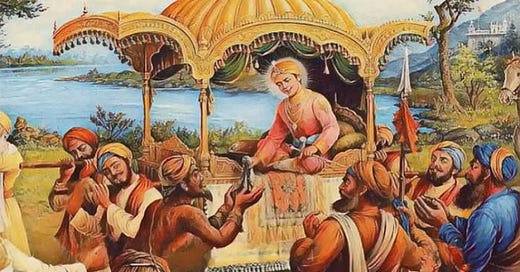Introduction:
The warrior’s sharpest tool is not his keen blade. The blade is ancillary to his foremost weapon, his mind. It is the mind that the greatest saints and warriors of their day have paid homage to. Strategists have emphasized its mastery for success and historians have lionized those few daring souls who have braved its perils to master it. It may seem that just about every great personality has emphasized that one master their mind but rarely have they provided the means of mastering the mind. What is the Sikh perspective on the mastery of the mind?
The Art Of Warriorhood:
The primary focus of the canonical Sikh Guru Granth, the faith’s scripture, is not to provide an otherworldly alternative or means of meditative escape to the next life. Rather, it elaborates that Sikhs surmount their base selves through a disciplined existence and then be reborn as warriors to wholeheartedly immerse themselves in the battle of life. This discipline is codified in the Sikh Rehat or code of conduct that is a simplified and practical interpretation of the poetical Guru Granth itself. Those who adhere to the Sikh discipline are the Khalsa.
ਨਾਨਕ ਸੋ ਸੂਰਾ ਵਰੀਆਮੁ ਜਿਨਿ ਵਿਚਹੁ ਦੁਸਟੁ ਅਹੰਕਰਣੁ ਮਾਰਿਆ ॥
ਗੁਰਮੁਖਿ ਨਾਮੁ ਸਾਲਾਹਿ ਜਨਮੁ ਸਵਾਰਿਆ ॥
ਆਪਿ ਹੋਆ ਸਦਾ ਮੁਕਤੁ ਸਭੁ ਕੁਲੁ ਨਿਸਤਾਰਿਆ ॥
ਸੋਹਨਿ ਸਚਿ ਦੁਆਰਿ ਨਾਮੁ ਪਿਆਰਿਆ ॥
ਮਨਮੁਖ ਮਰਹਿ ਅਹੰਕਾਰਿ ਮਰਣੁ ਵਿਗਾੜਿਆ ॥
“Nanak, only those warriors are valorous who slay their own arrogance first. The enlightened ones praise the divine wisdom that redeems their lives. They liberate themselves, resultantly, and their kin. They are acclaimed in the true court for their love of the true wisdom. The unenlightened ones die in arrogance spoiling even their demise.”
-Guru Granth, 86.
The Khalsa, as the apex of divine warriorhood, slays its own arrogance prior to acquiring arms to rule over the unenlightened mortals. Even if the Khalsa was to die, its demise would be unspoiled and inspirational influencing successive generations even from beyond the grave. Thus, the Khalsa is one who is said to have mastered the art of controlling the mind as countless ancients have emphasized.
The Mind:
What is the mind? It is a modicum of the Creator’s divinity having the divine creative writ inscribed on it but it is not tangible. It is the fount of human perception amalgamated with cognitive intelligence. Essentially, it may be likened to a container that houses the human intellect and is man’s greatest tool in the battle of life. The Guru Granth is emphatic,
ਮਨ ਤੂੰ ਗਾਰਬਿ ਅਟਿਆ ਗਾਰਬਿ ਲਦਿਆ ਜਾਹਿ ॥
ਮਾਇਆ ਮੋਹਣੀ ਮੋਹਿਆ ਫਿਰਿ ਫਿਰਿ ਜੂਨੀ ਭਵਾਹਿ ॥
ਗਾਰਬਿ ਲਾਗਾ ਜਾਹਿ ਮੁਗਧ ਮਨ ਅੰਤਿ ਗਇਆ ਪਛੁਤਾਵਹੇ ॥
“Mind, you are drowning in arrogance; you are totally loaded with it. You are blinded by the baits of illusion and die to be reborn again and again. Refusing to forfeit your attachment to illusion, you will die and be tormented in your last moments.”
-Guru Granth, 441.
The mind is intertwined with the self. To master the self is to master the mind. But how can the mind be mastered? The Guru Granth enjoins adherence to its practicality. One is to refrain from that which tempts their animalistic self; avoid the company of the base-minded ones and above all accept reality as the Hukam (the divine writ) of the Creator. Such an individual is likened to the true warrior. The Gurus expectation is that the Sikh tread their path to perfection and lay down their life in its service if need be. This can only be achieved if the Sikh disciplines themselves as his Guru commands:
ਤਿਆਗਨਾ ਤਿਆਗਨੁ ਨੀਕਾ ਕਾਮੁ ਕ੍ਰੋਧੁ ਲੋਭੁ ਤਿਆਗਨਾ ॥੩॥
“Renunciation: be noble and renounce your lust, wrath, and obsession.”
-Guru Granth, 1018.
The state of warriorhood that is reached in the state of Karamkhand or divine proactivity is the pinnacle of Sikh discipline. It is an arduous peak to ascend to, but the fruits make it all the more worth it.
ਮਾਨ ਮੋਹ ਮੇਰ ਤੇਰ ਬਿਬਰਜਿਤ ਏਹੁ ਮਾਰਗੁ ਖੰਡੇ ਧਾਰ ॥੩॥
“To abandon arrogance and trivial wranglings over mine and yours, this is the path that is keener than the blade.”
-Guru Granth, 534.
Negative Capability:
The human mind is a canvas. Although it retains the divine writ, it is also inscribed with the nefariousness of the unenlightened human existence. Resultantly, it becomes constricted and unable to be used for its possessor’s purpose. A warrior whose mind becomes myopic and stagnant becomes a barren field, unable to produce anything other than defeat. How to keep the mind fresh? John Keats (c.1795-c.1821) described the process as Negative capability.
Negative capability involves the acceptance of reality on its terms without any preconceived notions; to accept matters as they are and also try envisioning matters from the opposing side’s perspective. This allows greater insight into both one’s own mind and another’s. The negativity here is not one of vice but rather a virtue. This is how a warrior always keeps their creativity fresh and ever-ready for whatever new tribulation life may throw at them.
Conclusion:
The warrior’s sharpest weapon is his mind. All other physical weapons are ancillary. To master the mind is to master the self and there is no greater ally than the self for it is of divine origination. Thus, the Sikh warrior has his mind under his control. This was how Sikh martyrs of yesteryear accepted the most horrific of death. To master the mind is to master the world.






Please keep writing, I am learning so much from your work, as a young Sikh who grew up with non religious parents